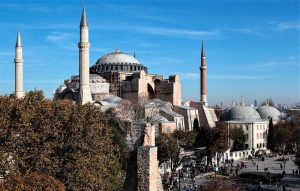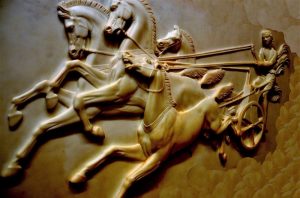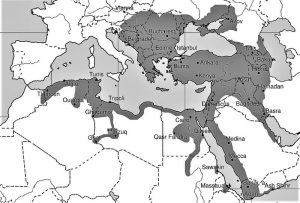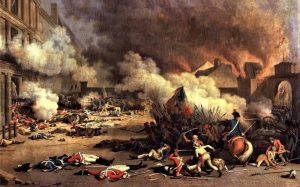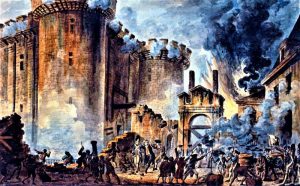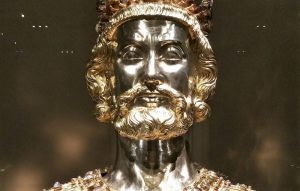Byzantine Empire
The Byzantine Empire is considered to be the continuation of the Roman Empire in the eastern part of the Mediterranean. It is an empire of Christian nature that was perennially at war against Muslims, flourishing during the reign of Macedonian emperors. It disappeared as a result of attacks by Seljucid Turks and Ottoman Turks.
What is the Byzantine Empire?
It can be defined as a Christian State created by different ethnic groups of great cultural, economic and political importance of the time, and whose existence originated after the fall and division of the Roman Empire after the reign of Theodosius I.
Summary
People who lived under the Byzantine Empire in its beginnings, saw themselves as Romans, but the culture of the empire changed over the years. By incorporating Greek and Christian culture, it became a unique Byzantine culture. The Byzantine Empire was influenced by the Latin, Coptic, Armenian and Persian cultures. Later, it was also influenced by Islamic cultures. Constantinople was an extremely diverse city and its residents were multi-ethnic and multi-religious. Taxes for foreign traders were the same as for Byzantine residents, and traders actively dealt with Mediterranean, eastern and western regions, including areas around the Black Sea, the Red Sea and the Indian Ocean.
Byzantine Empire formation
Byzantium was the name of a small but important city located on the Bosphorus, the strait connecting the Marmara Sea and the Aegean with the Black Sea and separating the continents of Europe and Asia. In Greek times, the city was on the border between the Greek and Persian world. In the 4th century B.C. Alexander the Great made both worlds part of his Hellenistic universe, and later Byzantium became an increasingly important city within the Roman Empire. Its formation came from the decision of the Emperor Diocletian to administer the Holy Roman Empire by means of two parts governed by an emperor and a vice emperor.
Stages
The empire is divided into three important stages:
- First Byzantine Gold Stage: at that time the Crusaders destroyed Constantinople.
- Second Byzantine Gold Stage: The Turks took Constantinople.
- Byzantine proto art: the iconoclastic quarrel appears in Justinian’s time.
Fall of the Byzantine Empire
The arrival of Emperor Michael VIII began the decline of the empire. During his mandate, the Turkish army was in charge of reducing the dominions of the Byzantine Empire. The changes that took place in society, also originated its fall, mainly on the part of the settlers and workers because they had to pay high taxes, and they decided to give up their lands.
Characteristics
- At first, the empire’s territories included Greece, Egypt, Turkey, Romania, Syria, Palestine, and Mesopotamia.
- Its population was very varied.
- The settlers preferred to call themselves “Romans“.
- The name Byzantine Empire was given in the sixteenth century by Hieronymus Wolf.
- They adopted Hellenic traditions and Greek language.
- The heyday of the empire came during the reign of Justinian I.
- The crisis stages of the empire were the 6th and 7th centuries.
Extension
In the beginning it covered the entire Mediterranean coast of Africa, the Anatolian peninsula, Greece, the Italic peninsula, Sicily, Sardinia, Corsica, the Balearic Islands, the Balkans and much of the Black Sea coast. During the 7th and 8th centuries the Muslims also managed to conquer the Mediterranean coast of Africa, Syria and Palestine and from that moment on, the Byzantine Empire was reduced to the Anatolian peninsula, the Balkans and southern Italy.
Emperors
Some of the most recognized emperors were: Arcadius, Theodosius II, Leo the Great, Zenon, Justinian I and II, Leontius, Philip Bardanes, Constantine X, Theodore, Michael VI, Eudoxia and Constantine VI.
Cultural events
One of the most important manifestations of Byzantine culture was orthodox Christianity. Byzantine society was very religious and held in high esteem certain values, including respect for order and traditional hierarchies. The family was the center of society, and marriage, chastity, and celibacy were celebrated and respected. Women and mothers were seen as important members of the family unit. The women had their own spaces, called gynaikonitis, where they engaged in activities such as spinning and weaving. They built large palaces and hippodromes, and their architecture offered a contrast between austerity and luxury. They built numerous churches, the main one being the church of Hagia Sophia. They were dedicated to agriculture and there was great cultural diversity. Learning was based on reading Homer and the Bible. Literature was related to the Greeks and art was based on icons with religious influence.
It was a theocratic state in which the emperor was considered the representative of God on earth and was the one who had all the political and religious power. He was followed by a large number of officials and armies. The society was hierarchical, and the slaves, peasants, merchants, clergy, army and nobility were distinguished.
Economy
The basis of its economy was agriculture through latifundia. Trade was quite austere, and they minted gold coins as the main method of payment. The importance of their economy lay in the Silk Road where silk, cloth and precious stones were traded.
Byzantine Empire contributions
The Byzantine culture was one of the most important and influential in today’s world because its methods were based on the hierarchical order. Other contributions were:
- Military education and political structure
- Trade began to be used as an economic activity.
- It began with the practice of Christianity
- The Roman laws were codified generating the Civil Law.
- The manual of legal techniques was created.
Location
It was located on the European side of the Bosphorus, a strait linking the Mediterranean with the Black Sea. This position was strategic because it served as a transit for trade with Europe and Asia Minor.
How to cite this article?
Briceño V., Gabriela. (2019). Byzantine Empire. Recovered on 23 February, 2024, de Euston96: https://www.euston96.com/en/byzantine-empire/
